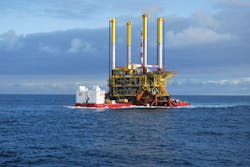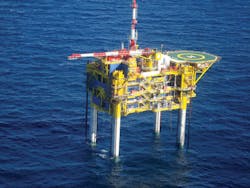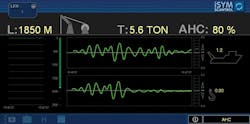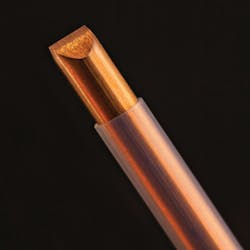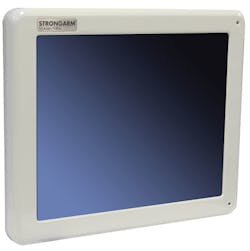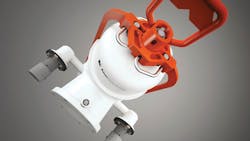New tools and technology for the offshore industry
MOSES minimizes redundant steel for ORCA Offshore platform
When Centrica acquired the F3-FA field in the Dutch sector of the North Sea, it planned to develop the field for four years of production and then relocate to another field. A $220-million, 9,000-ton (8,035-metric ton), self-installing and reusable platform was crucial to the project’s success. MOSES offshore platform design and installation software simulated and analyzed the transportation and installation of the unique production platform.
Tapping marginal fields
The F3-FA field was discovered in 1971, about 2 mi (3 km) below the surface of the North Sea. Centrica is the third owner and acquired the field along with its acquisition of Venture Production in 2009. With only about four to five years of production life, it would be too costly to develop the F3-FA field by installing a conventional fixed platform. Instead, Centrica planned to deploy a self-installing platform that is constructed in harbor, transported by barge, and installed by putting down legs on the seabed and elevating the platform. When the field is exhausted, the supports are taken up, and the platform is transported by barge to the next location. The cost savings across three or four marginal fields would be significant.
The F3-FA platform footprint measures 63-by-45 m (206-by-147 ft), and the structure reaches a height of 133 m (436 ft) above the seafloor. Each of four 440-ton (392-metric ton) suction piles is 13 m (42 ft) high and 15 m (49 ft) in diameter. The design weighed in at about 8,800 tons (7,857 metric tons). During transport, the platform’s piles would be raised and attached to the barge with temporary sea-fastening beams. Because of the size of the piles and the proximity to the wave zone, huge hydrodynamic loads would act on the piles. For the design to be viable, the team had to know the size of these loads at an early stage.
Unconventional analyses
It quickly became clear that the F3-FA platform design posed a challenge in strength management, in part because the four legs were without braces and subject to the direct force of the waves. The team used finite element analysis to model the entire platform including about 200 load cases. These included the static and dynamic loads, which had to be balanced to optimize steel quantities. Bentley MOSES offshore analysis and design software was used for the static calculation, in combination with an ANSYS model.
ORCA Offshore used MOSES to provide the multi-body dynamic analysis for the extreme conditions during transport. The challenge was to convince the project stakeholders that this unconventional method would give reliable results. The loads during transport and upon lowering the suction piles and legs had to be accurate to size the steel to hold them. MOSES determined those loads using a five-body model, with each body having its own hydrodynamic database to derive the motions and loads acting between bodies. A model test verified the MOSES results to the stakeholders’ satisfaction.
MOSES was also used to confirm the structural strength of the platform during transport and installation. The spectral structural analysis allowed ORCA Offshore to derive the structural loading without being unnecessarily conservative. Conventional methods would have determined the maximum load acting on each pile and combined that with maximum motion loads acting on the whole structure. The MOSES approach considered the natural relationship between loads to reduce the quantity of steel required for the platform itself and for the temporary sea fastenings.
Model tests
Compared to conventional analysis, ORCA Offshore’s analyses provided a more realistic representation of the loads and stresses during transport. Model tests carried out in a towing tank validated the transport plan for the F3-FA platform. After an initial attempt scuttled by severe weather, the successful transport journey to the F3-FA field in the North Sea took about three days. The platform withstood extreme wave loading, which proved the reliability of results produced by the project team’s unconventional methods of analysis. Installation work in the 40 m (131 ft)-deep water was concluded within 52 hours. The leg sea-fastening system required no steel cutting or welding. Suction piles were driven into the seabed using submerged water pumps, the entire topsides attached to the four legs with 16 two-ton super-bolts, and the 4,000-ton (3,571-metric ton) deck lift system used strand jacks to maximize workability. The whole design concept proved to be easy to install.
ROI across fields
With the integrated capabilities of MOSES, ORCA Offshore was able to perform the numerous analyses required to ensure fast, simple, and safe installation of the F3-FA platform. Optioneering support enabled design exploration to eliminate redundant steel work in the topsides and legs, resulting in reduced material costs.
Validating the self-installing platform concept and design had both environmental and economic benefits. All remnants of the self-installing platform are removed from the seabed upon relocation. The ability to reuse a self-installing platform three or four times over the course of its lifetime not only reduces production costs but also taps smaller reservoirs in marginal fields that would otherwise be too costly to operate. This ensures that oil and gas resources are fully exploited.
Scantrol advances its active heave compensation technology
Active heave compensation (AHC) technology adds significant value to the vessel by increasing its operational uptime. Scantrol says that its goal is to enable more crane and winch manufacturers to deliver AHC equipment.
In order to do this, Scantrol’s R&D effort is focused on developing cost-effective standardized solutions and smart tools for design, testing, operations, and support. The company says that this makes both the end-users and equipment manufacturers confident that AHC technology adds value to their product without causing extra uncertainty.
Active heave compensation is a technology used when lifting equipment in order to filter away the heave movement influencing a vessel during offshore operations. The principle is to keep the load motionless with regard to the seabed, a fixed installation or another vessel. AHC requires a control system that in real time actively controls the equipment to work against the wave caused movements. AHC technology is used in many applications. Offshore cranes, launch and recovery systems for ROVs (LARS), wellhead intervention winches, oceanographic winches, ship-to-fixed installation gangways are all candidates for AHC technology.
Recently, by retrofitting a secondhand crane winch onboard the M/V Island Performer, Scantrol says the customer was able to save time and cost compared to investing in a new system.
Zeus debuts polymer advances
Polymer extrusions are changing the landscape of what is now possible when operating in deeper and hotter environments. Zeus has developed its new polymer, polyetheretherketone (PEEK) to withstand higher temperatures and pressures in aggressive environments. The company says that PEEK is now recognized as one of the world’s highest performing thermoplastics due to having one of the highest strength-to-weight ratios of any thermoplastic on the market, along with its ability to stand up to temperature and chemicals.
With PEEKShrink, an alternative to traditional protective coatings like Teflon or Kapton tape, a spliced joint becomes one of the most reliable components due to enhanced electrical, chemical, and thermal properties. When paired with a high-performance magnet wire such as PEEK or Kapton, this wire splicing method helps push exploration to new depths. PEEK magnet wire may be varnished or act as a stand-alone insulation. PEEKShrink acts as “second skin” to wire, ensuring accurate data transmission.
In 2014, Zeus debuted its high-temperature fluoropolymer product family, NeoTem. This new perfluropolymer offers a continuous service temperature of 300°C (572°F) alongside excellent dielectric strength, chemical resistance, and permeation resistance. NeoTem is now a commercially available polymer that has opened the potential to address many applications from electrical insulation for submersible pumps, to MWD tools and motor lead extension cables.
Like wire insulation, optical fibers need advanced protection from chemicals and abrasion. NeoTem offers heat resistance up to 300°C while PEEK-with the highest strength-to-weight ratio of any thermoplastic-makes an ideal candidate for sensing applications requiring abrasion resistance. New applications in engineered surface tubing reduce drag force and friction on tubing with channels extruded into the outer diameter, inner diameter, or both. This technology allows fiber-optic sheathing to reduce friction by as much as 40% on PEEK tubing without the use of additives, leading to decreased strain and more precise readings during exploration.
Also, the new polymer offers chemical resistance and low permeation properties to improve insulation in tubular slot liner systems.
Strongarm introduces certified panel PC
Strongarm Designs, Inc., has introduced the Vulcan, a versatile, feature-rich US/CAN and ATEX/IECEx certified panel PC. The device is rugged enough for use in any onshore or offshore application. The Vulcan is certified for use in both Division 2 and Zone 2 hazardous environments. The company says that the Vulcan’s extended operating temperature (-35°C to 60°C) makes it the best HMI solution for any application.
The Vulcan’s heavy-duty yet slim construction features all corrosion-resistant materials and a durable UV resilient powder-coated finish. The design features precision-cast assemblies and a shatterproof touchscreen allowing it to withstand the rigors of the most demanding applications. The Vulcan’s auto-dimming sunlight-readable display makes it perfect for outdoor or indoor applications, and its design requires no active cooling or heating. Strongram says that the Vulcan has repeatedly outperformed the competition in sunlight readability, reliability and responsiveness. Additional features like field swappable hard drives, diagnostic LEDs and field serviceable components means less costly downtime.
The Vulcan is available in both DC (12-36VDC) and AC (100-240VAC) versions for use anywhere and has a wide range of mounting options in the industry: panel-mounted, rig-mounted, yoke- mounted, as well as Strongarm’s exclusive Vertica arm mounting, a vertically-adjustable pendant arm.
The Vulcan is available in both 15-in. and 19-in. display sizes and features either an Intel i7 Dual Core or Quad core processor for superior performance. Also available from Strongarm is the Vulcan View, a display only option featuring the same certifications, features and durable construction as the Vulcan but without the integrated PC.
Aker introduces subsea electric actuator
Aker Solutions has unveiled a rotary subsea electric actuator.
In 2013, the company started the El-drive program to develop products and technology in electric actuation for future system deliveries. The program had two main goals. The first was to develop a framework of modular building blocks (platform) that can be used to build specific products to electrically actuate subsea valves. The second goal was to showcase the platform by building subsea electric actuator technology that could be used in subsea production systems and process systems solutions.
The first stage of the program was completed with the release of two electric actuator types. The 400VAC direct drive is a high-duty actuator that can do continuous control valve operations, while the 24VDC battery-driven system is dedicated to operate non-continuous valves, like isolation valves.
The resultant permanently installable rotary electrical actuator can be used to operate subsea valves with an ISO13628-8 ROV class 4 interfaces in process systems and subsea production systems.
The company says that the all-electric system will enable cost savings both on topsides and for umbilicals. It also should lead to cost reductions and more flexible subsea production systems compared with conventional electrohydraulic systems.
Baker Hughes releases geospatial navigation, analysis LWD service
Baker Hughes has made the commercial release of its VisiTrak LWD service for geospatial navigation and analysis.
VisiTrak combines pre-well modeling, logging-while-drilling (LWD) sensors, proprietary visualization software, and precise reservoir navigation to improve well construction efficiency and optimize well placement, said Baker Hughes.
While drilling, extended-depth LWD readings determine the distance to, and angle of, adjacent bed boundaries to visualize complex reservoir architecture in real time, up to 100 ft (30 m) from the wellbore in every direction.
“Most of today’s wellbore placement strategies rely on surface and downhole seismic measurements, and drilling time-consuming pilot holes to confirm the top and base depth of the reservoir,” said Tom Thissen, president, Drilling Services at Baker Hughes. “Because the VisiTrak LWD service can identify multiple bed boundaries at up to five times the distance of conventional services in real time, operators can make faster drilling decisions to navigate to the most productive zones, while eliminating unnecessary rig time.”
Baker Hughes recently deployed the VisiTrak LWD service offshore Brazil while drilling a 3,340-ft (1,018-m) horizontal section through a series of poorly identified sand channels. Using the new service, the wellbore was placed accurately in and navigated through the single productive sand channel. The well exposed a total net sand length of 2,838 ft (863 m), equating to a 75% net-to-gross ratio of landed payzone.

